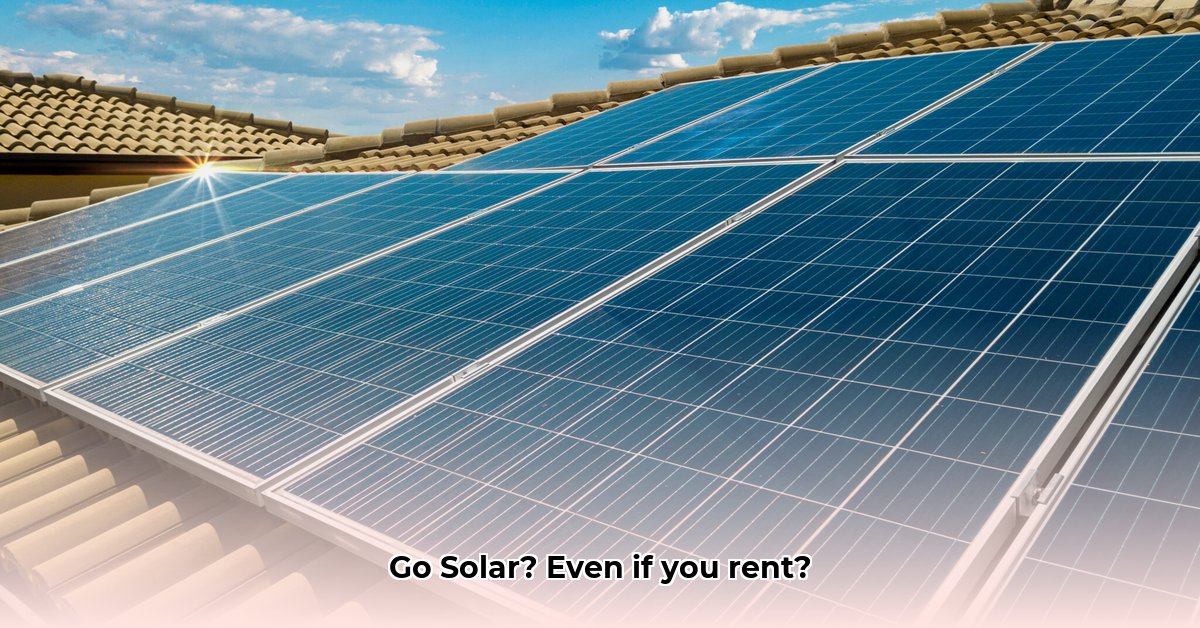Renting an apartment doesn’t mean you’re locked out of the solar revolution! This comprehensive guide shows you how to harness the power of the sun, even without owning your building. We’ll explore practical and innovative ways to save money on your energy bills and embrace sustainable living. From joining a community solar program to utilizing portable solar panels and even looking ahead to future technologies, we’ll cover everything you need to know. Learn the pros and cons of each approach, get tips for choosing the best fit for your apartment and lifestyle, and discover how to maximize your energy efficiency. Get ready to go solar – even if you’re just renting! For mobile home residents, check out options like this.
Solar Energy Apartments: Your Guide to Sunny Savings
Dreaming of harnessing the sun’s power but renting your space? You’re not alone! Many renters are discovering ways to go green and reduce their energy bills. Let’s dive into the top options for bringing solar energy into your apartment life.
Community Solar Programs: Shared Sunshine
Imagine a large solar farm generating clean energy, and you’re a part of it! With community solar, you subscribe to a portion of a centrally located solar power plant. Residents then use credits from the community solar project to offset their own home electricity consumption, saving money every month on their energy bills. You don’t need a suitable solar rooftop to participate and still pay less for electricity, even if you live in an apartment complex.
Getting Started with Community Solar:
- Find Local Programs: Search online for “community solar” plus your city or state. Many websites dedicated to renewable energy can also be a great starting point, as well as contacting your local utility.
- Compare the Details: Carefully review the fine print. Look at subscription fees, contract lengths, and projected savings on your monthly energy bills. Some states are even piloting programs aimed at expanding low-income households’ access to community solar.
- Understand the Billing: In most community solar setups, you’ll receive two separate electric bills each month once you subscribe to a project – one from your utility and one from your community solar provider summarizing your earned credits and what you owe for the credits.
- Sign Up and Shine: Once you’ve found the perfect fit, sign up! You’re contributing to a greener future and likely seeing a reduction in your electricity expenses!
Weighing the Pros and Cons of Community Solar:
| Feature | Pros | Cons |
|---|---|---|
| Lower Bills | Substantial savings on your electricity bills are possible, depending on the program. Many community solar subscribers save 5 to 15 percent off their typical electricity bills. | Actual savings depend on factors like your usage, the program’s design, and location. Some programs can be more expensive. |
| Eco-Friendly | Significantly reduces your reliance on fossil fuels and lowers your carbon footprint. | The overall environmental impact of the solar farm itself needs consideration. |
| Renters’ Choice | A fantastic option for those who rent and can’t install their own solar panels. | Availability varies by region, and some programs might have complicated structures. |
Portable Solar Panels: Solar On the Go
For something smaller-scale—powering your phone, laptop, or a small fan—portable solar panels are a great option. These panels are lightweight and easy to transport, perfect for camping trips, emergencies, or simply topping off your devices when you’re short on power. Portable solar panels provide a green alternative for charging devices, promoting sustainability on a smaller scale.
The Upsides and Downsides of Portable Solar:
| Feature | Pros | Cons |
|---|---|---|
| Mobility | Take them anywhere! Perfect for travel, outdoor activities, or power outages. | Limited power; they can’t run appliances that need a lot of electricity. |
| Affordability | Relatively inexpensive compared to larger solar energy systems. | Only suitable for small electronics, not for powering major household appliances. |
| Eco-Boost | Reduce dependence on the power grid for smaller electronics. | Manufacturing and disposal of these panels still have some environmental consequences. |
| Versatility | Some units are lightweight and made for camping, hiking, and RV travel fold neatly into a small package with a handle. | Requires outdoor space where you can safely secure panels—a sunny patio, yard, rooftop, or balcony. |
Other Ways to Save Energy
Don’t overlook simple solutions. One of the easiest and most impactful things you can do is ditch the dryer and let the sun do the work for free. If you can’t convince your landlord to install out-the-window clotheslines, consider a more portable, retractable option.
The Future is Bright: Solar Innovations on the Horizon
The world of solar energy is constantly evolving! Exciting new technologies, like solar windows (windows that generate electricity!), are currently under development and hold immense potential for apartments. Prototypes from Michigan State University and the National Renewable Energy Lab are attractive alternatives to dark, portable panels that block the light and take up space. These solar innovations promise a future where sustainable energy solutions are seamlessly integrated into urban living.
Remember, even if you rent, you can still be a part of the solar revolution. Explore the options that best suit your needs and budget. The sun’s energy is waiting to be harnessed, and the future of apartment-friendly solar is looking brighter than ever!
How to Compare Community Solar Program Costs and Savings for Renters
Key Takeaways:
- Community solar can significantly reduce electricity bills (5-15% savings).
- Comparing offers is crucial for maximizing benefits and ensuring long-term financial advantages.
- Understanding project capacity, location, and contract terms is vital for making informed decisions.
- Weigh the pros and cons of fixed versus variable discount models to align with financial goals.
- Consider long-term energy needs and potential changes in utility rates to ensure continued savings.
Renting shouldn’t mean missing out on the benefits of solar power. Community solar programs offer a way for renters to participate in clean energy and reduce their electricity bills.
Understanding Community Solar Benefits
Community solar lets you buy a share of a solar farm’s output, even if you can’t install panels on your roof. This offers a practical solution, enabling renters to contribute to sustainable energy production.
How to Compare Community Solar Program Costs and Savings for Renters
Here’s your guide to finding the best community solar deal:
Step 1: Research Local Programs
Start by searching online for “community solar programs [your state/city]”. Contacting your local utility is also a good idea.
Step 2: Compare Discount Models
Programs offer two main discount types:
- Fixed Discount: A set percentage off your bill each month for predictable savings.
- Variable/Rate-Based Discount: Savings fluctuate with changes in utility rates –potentially higher savings, but also more risk.
Step 3: Evaluate Project Location and Capacity
- Location: A closer solar farm means less energy loss during transmission.
- Capacity: Does the program offer enough power for your needs?
Step 4: Scrutinize Contract Terms
Carefully read the fine print. Pay attention to:
- Contract length: How long are you committed?
- Cancellation policy: What are the terms if you move or want to leave the program?
- Customer service reputation: Research online reviews to gauge the provider’s responsiveness.
Step 5: Calculate Your Potential Savings
Many websites offer community solar savings calculators. Input your current energy usage to estimate potential savings under various programs.
Step 6: Make an Informed Decision
Consider the long-term implications. Will the savings justify the commitment, even if utility rates change?
Pros and Cons of Community Solar for Renters
| Feature | Pros | Cons |
|---|---|---|
| Cost Savings | Reduced electricity bills (5-15%). Many community solar subscribers save 5 to 15 percent off their typical electricity bills. | Savings can fluctuate with variable discount models. Some community solar programs may be more expensive than your current electricity bill. |
| Environmental Impact | Supports renewable energy, reduces carbon footprint. With community solar, you are connected directly to clean energy projects in your community. The more projects around you that fill up and go live, the more clean energy gets connected to your local grid. | You aren’t directly controlling the solar flow. |
| Accessibility | Excellent option for renters and those ineligible for rooftop solar. Since you don’t need a suitable solar rooftop to participate in a community solar project, it’s an excellent option for renters. | Limited control over program details. |
| Simplicity | Relatively easy to sign up for. | Research and comparison are necessary before signing up. |
- Hydro Extrusions USA Leads North American Aluminum Profile Solutions - December 28, 2025
- Hydro North America Leads Aluminum Extrusion Solutions Across Diverse Industries - December 27, 2025
- Hydro Extrusion North America Provides Custom Solutions Across Diverse - December 26, 2025
















